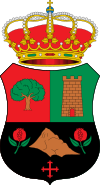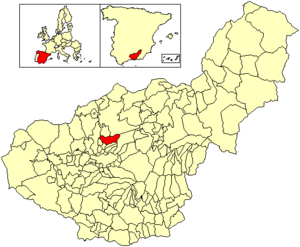Cogollos Vega facts for kids
Cogollos Vega is a small town in the province of Granada, Spain. It sits at the base of the Sierra de Cogollos mountains. In 2010, about 2,068 people lived there.
This town is located in the northern part of the Granada province. It is only about 14 kilometers (9 miles) from the main city of Granada. Cogollos Vega shares its borders with several other towns. These include Deifontes, Iznalloz, Huétor Santillán, Nívar, Güevéjar, Calicasas, and Albolote.
History of Cogollos Vega
Early Settlements
People have lived in the area of Cogollos Vega for a very long time. We know this because traces of settlements from the Palaeolithic era (the Old Stone Age) have been found here. Later, people from Roman times and the Visigoths also lived in this area.
Arab Influence
The town was also home to Arabs for many centuries. It was part of a special district called Vega. This district included other towns like Alhendín and Alfacar. The famous writer Ibn al-Khatib even mentioned Cogollos Vega in his writings.
Records show that the town existed before the 14th century. Muslim people, often called Moors, lived there until they were asked to leave in 1572. The town was then empty for eight years.
New Settlers
In 1580, about eighty new settlers arrived. Most of them came from a town called Jaen Huelma. A survey from 1752, called the Cadastre of Ensenada, showed that 259 people lived in Cogollos Vega at that time.
Connection to Granada
The history of Cogollos Vega is closely connected to the city of Granada. This is because it is very close to Granada. It is also located between Granada and the beautiful Sierra de Huétor Natural Park. This park is part of a larger mountain range called the Baetic System. The area has many oak trees and amazing views.
Events and Attractions
Local Events
Easter Celebrations
During Easter, several religious services take place in Cogollos Vega. On Good Friday, there is a special procession. Five important religious statues are carried through the streets. These include the Virgin of Sorrows and the Crucified Christ of Nazareth. There is also a smaller Virgin statue, traditionally carried by younger people, and the Holy Sepulchre. On Palm Sunday, another procession happens with palms and olive branches.
Cross Day (May 3)
On May 3rd, the town celebrates Cross Day. People organize events at different spots around the town. This day is often called "oven day" locally, which refers to a traditional activity.
San Antonio Festival (June 13)
San Antonio is the patron saint of Cogollos Vega. Around June 13th, the town holds a Cultural Week. This week is full of fun events for both kids and adults. On June 13th itself, a procession carries the statue of San Antonio through the main streets.
Blessed Sacrament Festivals (October)
These festivals are held on the first weekend of October. On Sunday, there is a procession for the Blessed Sacrament.
Main Attractions
Arab Baths - 12th Century
The Arab Baths are a very old and important building in Cogollos Vega. They are located in the oldest part of town. For many years, these baths were used as regular houses.
The baths have three main rooms connected by arches and special domed ceilings. These ceilings have unique octagonal skylights. The way the rooms are set up suggests they might be from the time of the Taifas, which were early Muslim kingdoms.
The Arab Baths of Cogollos Vega are considered a historic artistic monument. This means they are very important for culture and history. The Spanish Ministry of Culture has even started plans to restore them.
These baths were built around the 12th century. They are a great example of rural Muslim baths. They have lasted so long because they were built very strongly. After they stopped being used as public baths in the 16th century, people started living in them.
Public baths were important places in Roman and Muslim times. They were where people met and kept clean. But when Christians took over, public baths were not part of their customs. So, the baths became a normal house. You might not even notice them today, except for the big stone blocks on a corner and a sign that says "Arab Baths."
When you enter, you first find a rectangular room. This was the cold room, also called the apodyterium. It was used for changing clothes and for people to greet each other. Through an arch, you enter the second room, the warm room or tepidarium. This room is wider and taller. Its ceiling has twelve hexagonal skylights. These might have let in colored light, making the room feel calm and steamy.
The third room is the hot room or caldarium. It is a little wider than the warm room. It has fourteen hexagonal skylights, which are very rare and make these baths special.
For a long time, only local people knew about these baths. Then, in the late 19th century, an art historian named Manuel Gomez Moreno studied them. He made a plan of the baths, which was shown in a museum. In 1987, the town bought the baths for 4.5 million pesetas (which was the old Spanish money).
In 1991, the baths were officially declared a historic-artistic monument. Later, in 1996, some work was done to remove newer walls and clean parts of the building. The government plans to spend a lot of money to fully restore the baths. In the future, there are plans to create an archaeological and ethnographic museum there.
Church of the Annunciation - 16th Century
The Church of the Annunciation was built in the 16th century. It stands on the spot where an old mosque used to be. The church tower has special wooden ceilings called Mudejar coffered ceilings. Mudejar is a style that mixes Christian and Muslim art.
Inside the church, you can see a beautiful altarpiece from the 18th century. An altarpiece is a decorated screen behind the altar. This one is in the Baroque style, which is very fancy. There are also valuable paintings, including one thought to be by the famous artist Alonso Cano. The church also has other precious decorations and silver items. The sculptures in the church were made by artists from the Granada school in the 17th and 18th centuries.
Arab Watchtower
There is an old watchtower in Cogollos Vega. It is also known simply as "the Tower." It is round and made of large stones. It has a brick archway. This tower was used as a lookout point during the time of the Moors. It was also used during the Spanish Civil War.
The tower is located high up, at 1,160 meters (about 3,800 feet) above sea level. From here, you can see amazing views of the Granada plains, the Sierra Arana mountains, and other areas. The tower has been restored recently and now has a special lookout point for visitors.
Peñón de la Mata
The Peñón de la Mata is a mountain peak that is 1,669 meters (about 5,476 feet) tall. On its slopes, archaeologists have found remains of settlements from the Neolithic period, which was the New Stone Age.
During the Spanish Civil War, the area around Cogollos Vega was a battleground. The Peñón de la Mata was the site of a very important battle in the Granada province. It became a strong point for one side, the Republican army, because of its good location. You can still see many trenches there today, which are proof of the fighting that happened.
Water Cave
La Cueva del Agua, or the Water Cave, is located on the slopes of the Cabezo del Asno peak in the Sierra Arana mountains. You can reach it by two forest roads.
This cave is very special. It is a deep hole, more than 180 meters (about 590 feet) deep. It is mostly in its natural state. The cave has tunnels and chambers that stretch for over three miles (5 kilometers).
Since 1969, a special group has managed the cave. This group includes important people from the area. Also, since 1991, there is an advisory committee. This committee includes people from the towns of Iznalloz, Deifontes, and Cogollos Vega, along with the University of Granada. They all work together to manage and protect the cave.
Images for kids
See also
 In Spanish: Cogollos de la Vega para niños
In Spanish: Cogollos de la Vega para niños







